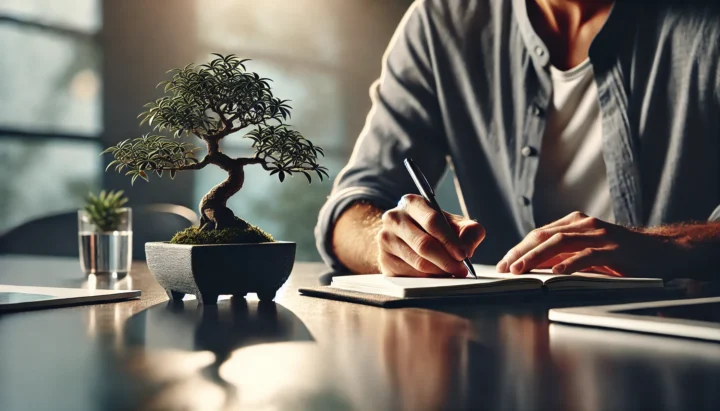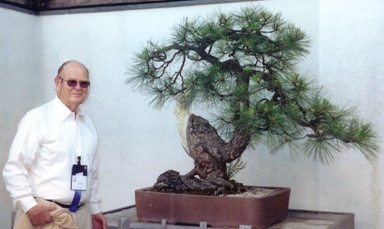By Kyuzo Murata
(with condensation and setting by Khan Komai)
The summer of 1975 saw the venerable 73-year old bonsai master, Kyuzo Murata, appear on the scene of American bonsai and move across the country in whirlwind fashion.
He spoke to the people in Japanese with a written English translation following, and everywhere as the cry, “Is there a copy of the talk?”, so much he said seemed so meaningful.
There was no copy of the translation except the one he carried, and it was months later before copies were sent from Japan by Murata long with his permission to use any or all of the material.
To take parts of the talk and call them more meaningful than others may be a sacrilege, but here are some excerpts from the speech.
“Bonsai is living plant transferred to a pot or tray or on a rock or stone so that it can continue to live semi-permanently. It has not only a natural beauty of the particular plant but the appearance reminds people of something other than the plant itself. It could be a scene, a forest, or a part of a forest, a lone tree in the field, a seascape, a lake, a river or a stream or a pond. It is also possible that a certain appearance reminds you of wind blowing over these scenes.
“In Japan the definition of bonsai is to create a natural scene on a tray using plants as the main material.”
“When you take a hachiuye, or potted plant, you can only see ‘prettiness of the plant or flower’ and it does not remind you of anything else. It is possible, however, to change the hachiuye… into bonsai.”
“The art of bonsai was developed in Japan where there were four seasons, clear water and clean air…, a 1500-year history, many old, unchanging traditions and customs. Among all these things the art of bonsai has grown to be what it is today.”
“We must not forget that the unique conception of what we call beauty in Japan is a little different from the western conception of beauty.”
“I do not think that bonsai could have developed or survived in the tropical or frigid zones…. Bonsai’s association with the change of seasons, mountains, valleys, rivers, waters, lakes, storms, gentle winds, rains, snow, frost and many other phenomena is far more important than one can imagine. Japan is one of the few fortunate countries that has all these things.”
“I believe bonsai should not be a mere sketch of a scene or a three-dimensional exhibit from a photograph or a scene. It is… all right to use nature as your subject, but your goal should be a sketch which has been refined and trimmed in your mind before you start creating. Only then can you call it art (and)… bonsai can be defined as a union of nature and art.”
“The Noh play or ballet expresses its movement in a relatively short time, on the other hand, you can hardly notice the slow growth of bonsai. The object of bonsai is to simulate nature. Nature expresses eternity in very, very slow movement and bonsai demonstrates this concept of the slow process of nature.”
“When your concept of bonsai comes this far, then you cannot avoid going into the world of ‘wabi’ or ‘sabi’.”
“It is an almost impossible task to try to explain (the) meaning of wabi or sabi because they are concepts of feeling which were created and actually only felt by the Japanese people over many, many generations and they were unknown to westerners until recently.
“Wabi is a state of mind, or a place or environment in tea ceremony or in haiku. It is a feeling of great simplicity, quiet yet dignified.”
“Sabi is a feeling of simplicity and quietness which comes from something that is old and used over and over again.”
For instance, picture yourself standing at a corner of Ryoanji’s stone garden in Kyoto in the evening in late autumn in a misty rain. You are viewing the garden: the next moment you close your eyes and are deep in thought. Actually there is nothing in your mind. It is empty, and yet your mind, and your heart is filled with a certain contentment. That feeling is wabi.
“I firmly believe the final goal of creating bonsai is to create the feeling of wabi or sabi in bonsai. This is the ultimate goal of the art of bonsai… I cannot help thinking that the essence of philosophy is to seek truth, virtue, and beauty; and it so happens that these are the essence of bonsai.”
“The feeling of wabi or sabi is something almost stoic which eventually leads us to Zen Buddhism.”
“They are not easy going feelings, they are very disciplined feelings. It is quiet but severe. The feeling is common among people who are very religions and people who create bonsai. I think this feeling is love, love for the trees, love for human beings.”
“Bonsai is a strange art wherein one can produce a feeling of reality of nature by manipulation, over a long period of time of trees, stones, rocks, trays or pots. And every bonsai is an original. No two bonsai are alike.”
“You can never finish or complete the creation of bonsai. It goes on and on forever.”
“In the art of bonsai there is no particular school for teaching techniques as you have in flower arrangement…. Limiting your bonsai technique to a certain style is to ignore the physiology of the tree.”
“If you try to enforce your own particular design on a tree without considering its nature, the tree may eventually die. You need to understand this limitation….”
“A truly fine bonsai depends basically on three factors: natural light, air, and water.”
“…trees in bonsai trays… are, I believe the longest living plants which you help to grow and sustain with love and which share your joys and sorrows.”
“They say the life span of an average cherry tree in nature is about 120 years, but it is not rare to see much older cherry trees as bonsai.”
“It becomes a sort of religion when you start loving a bonsai which has a much longer life span than your own.”
“I have been with bonsai every day for the past 60 years, and I come across problems almost every day about fertilizers, about uetsuchi, or soil for planting, about watering, about stones or rocks, about wiring.”
“Recently I have come to my own conclusion that the most challenging technique in the art of bonsai is to transform a most unnatural looking tree into a most natural looking tree.”
“For instance, there is a famous zelkova… created by Mr. Ogata (who)… severed the main trunk… and created a totally new look. When I first saw it at the… Kokufukai Exhibition, I laughed at it, (but over the years it has become) recognized as one of the finest bonsai in Japan.”
“It really is a strange looking tree. You would never find such an unnatural looking tree in the world, yet it looks exactly like a huge zelkova tree standing alone and strong in the field.”
(As in the) art of calligraphy, you can have two ways of writing alphabets, capital letters and small letters. I think we can apply the same variation to bonsai. When you try to sketch the natural scenery, you may use either capital letters or small letters because the basic goal is the same, but your method of approaching this goal is different. This is the area in which you can express your feeling freely.
But “again I wish to emphasize that bonsai is not a mere sketch of nature but a reflection of the heart of its creator.”
“Ladies and gentlemen, please create your own Americanized bonsai and fill this world with peaceful art.”

 May 12-13, 2012
May 12-13, 2012
